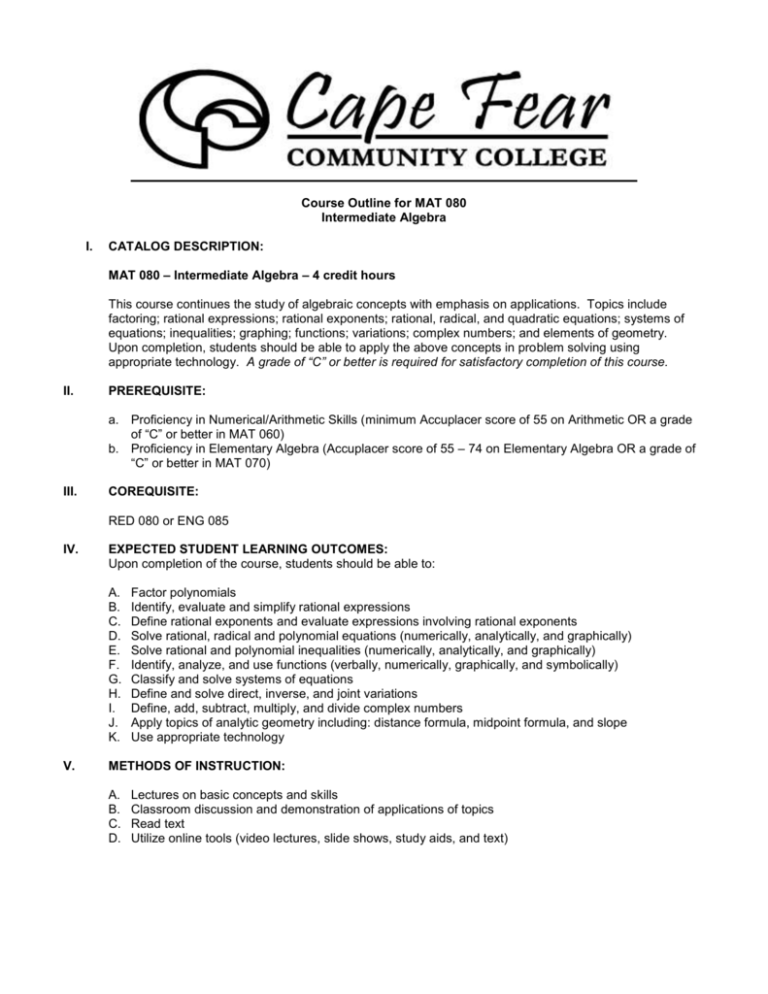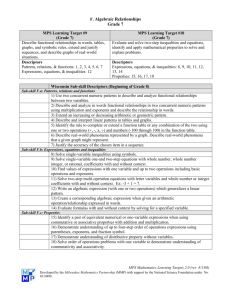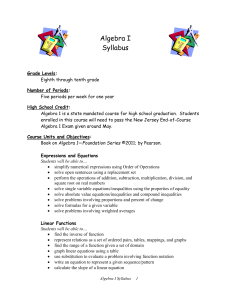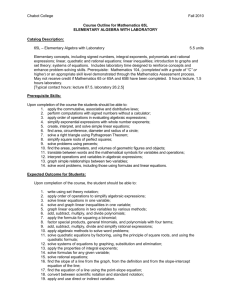
Course Outline for MAT 080
Intermediate Algebra
I.
CATALOG DESCRIPTION:
MAT 080 – Intermediate Algebra – 4 credit hours
This course continues the study of algebraic concepts with emphasis on applications. Topics include
factoring; rational expressions; rational exponents; rational, radical, and quadratic equations; systems of
equations; inequalities; graphing; functions; variations; complex numbers; and elements of geometry.
Upon completion, students should be able to apply the above concepts in problem solving using
appropriate technology. A grade of “C” or better is required for satisfactory completion of this course.
II.
PREREQUISITE:
a. Proficiency in Numerical/Arithmetic Skills (minimum Accuplacer score of 55 on Arithmetic OR a grade
of “C” or better in MAT 060)
b. Proficiency in Elementary Algebra (Accuplacer score of 55 – 74 on Elementary Algebra OR a grade of
“C” or better in MAT 070)
III.
COREQUISITE:
RED 080 or ENG 085
IV.
EXPECTED STUDENT LEARNING OUTCOMES:
Upon completion of the course, students should be able to:
A.
B.
C.
D.
E.
F.
G.
H.
I.
J.
K.
V.
Factor polynomials
Identify, evaluate and simplify rational expressions
Define rational exponents and evaluate expressions involving rational exponents
Solve rational, radical and polynomial equations (numerically, analytically, and graphically)
Solve rational and polynomial inequalities (numerically, analytically, and graphically)
Identify, analyze, and use functions (verbally, numerically, graphically, and symbolically)
Classify and solve systems of equations
Define and solve direct, inverse, and joint variations
Define, add, subtract, multiply, and divide complex numbers
Apply topics of analytic geometry including: distance formula, midpoint formula, and slope
Use appropriate technology
METHODS OF INSTRUCTION:
A.
B.
C.
D.
Lectures on basic concepts and skills
Classroom discussion and demonstration of applications of topics
Read text
Utilize online tools (video lectures, slide shows, study aids, and text)
VI.
CONTENT:
A. Linear Equations and Applications: Addition and multiplication properties of linear equations in one
variable, classification and solving linear equations, formulas, applications of linear equations in one
variable
B. Linear Inequalities and Absolute Values: Interval notation, addition and multiplication properties of
linear inequalities in one variable, set operations, compound inequalities, absolute value equations and
inequalities
C. Graphs, Linear Equations, and Functions: The Cartesian coordinate system, ordered pairs, slope,
linear equations in two variables, graphing linear equations in two variables, writing equations of lines,
parallel and perpendicular lines, functions, variations with applications
D. Systems of Linear Equations: Consistent and inconsistent systems, dependent and independent
equations, methods for solving linear systems of two and three equations, applications of linear
systems of equations
E. Exponents and Polynomials: Apply the laws of integer exponents, evaluate polynomial functions,
addition of polynomials, subtraction of polynomials, multiplication of polynomials, division of
polynomials
F. Factoring: Greatest common factoring, factor by grouping, factoring trinomials, special factoring,
solving equations by factoring and the zero product rule
G. Rational Expressions: Multiplication and division of rational expressions, addition and subtraction of
rational expressions, domains of rational functions, simplifying complex fractions, solving equations
with rational expressions, applications of rational expressions
H. Roots and Radicals: Properties of radical expressions, apply the laws of rational exponents, simplifying
radical expressions, addition and subtraction of radical expressions, multiplication and division of
radical expressions, solving equations with radical expressions, perform basic operations with complex
numbers
I. Quadratic Equations, Inequalities, and Graphs: The principle of square roots, completing the square,
the quadratic formula, applications of quadratic equations, quadratic and rational inequalities
VII.
TYPICAL ASSIGNMENTS:
A. In class participation during lecture
B. Online or textbook homework
C. In class chapter tests
VIII.
EVALUATION:
A. Methods of Evaluation
1. Sectional Homework
2. Chapter Tests
B. Frequency of Evaluation
1. Two homework assignments per each of the content areas A, C, D, E, F, G, and H; One homework
assignment per each of the content areas B and I
2. Five tests covering the nine content areas
IX.
TYPICAL TEXT:
A. Intermediate Algebra Ninth Edition by Lial, Hornsby, and McGinnis; Pearson: Addison Wesley,
ISBN 13: 978-0-321-57497-8
a. Since the text is included as part of the online portion of this course, it’s purchase is optional.
X.
OTHER SUPPLIES REQUIRED OF STUDENTS:
A. A MyMathLab student access code (bundled with new texts or purchased separately)
B. A scientific or graphing calculator, depending on each student’s math curriculum requirements
C. It is highly recommended that students in Distance Learning sections have internet access
Creation date: April 5, 2010
Revision date: July 27, 2010









